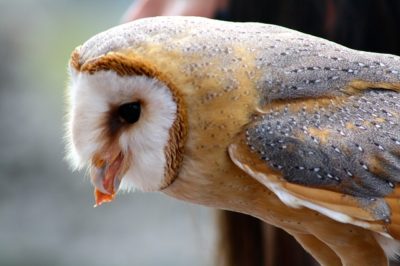Rodents in your fields and gardens can decimate your crop, and their resilience and numbers make them hard to eliminate. Enter your new best friend: an owl. Owls love to eat rodents, mice, rats, voles and sometimes larger animals like moles. A nesting owl is a killing machine, storing dozens of dead rodents in preparation for incubating the eggs. Barn owls don’t build their own nests, however; they look for sheltered places to roost and nest. Traditionally invited into barns, today’s owls rely on natural crevices and man-made boxes to find a place to hatch and rear young.
Barn owls live in North America year-round. Most will nest in the spring, although some will do so at other times throughout the year, laying an average of six eggs per nest. The female remains on the nest until the eggs hatch, and spends much of the first three months with the owlets. She relies on the male to deliver prey; a brood will eat 60-70 pounds of prey on average in its first three months. That’s a lot of mice that won’t be able to eat your crops.
Where Can You Build a Nesting Box
Barn owls like to roost inside buildings, but it doesn’t matter what type of building or where it is on your property, so long as it isn’t frequently disturbed by human activity. You can also place a box on the exterior of a building or a tree, provided you direct the opening away from the prevailing winds.
Diatomaceous Earth: The Best All-Natural Wormer For Your Livestock
Owls will choose a covered nesting site that is quiet, secluded and a suitable size. You can place your barn owl nesting box in any building, so long as you consider these factors:
- Rodenticides: Don’t place a barn owl nesting box on property where you are using poison to control pests. Ask your neighbors if they are doing so, as well. If they are, let them know you want to start attracting owls to the neighborhood; they may be grateful for the safer, cheaper alternative.
-
Traffic: Another safety concern for your owls is vehicle traffic near your property. Owls will frequently soar low to the ground as they approach their roosts, and can be hit and killed by passing cars. Don’t place a nesting box facing a busy road, or anywhere too near it.
- Noise: Owls are noisy! Be prepared to hear your owls screech and hoot in the night. For this reason, you may not want to place the nesting box near a bedroom wall or too near the house.
- Nearby fields: Owls will need fields or meadows near the nesting site to hunt; placing your box near a hunting ground also raises the likelihood owls will find it in the first place.
- Height: Owls need nesting boxes 8-12 feet from the ground in order to protect the young owls from raccoons and other predators. Don’t place the box too high, or it may not be seen by owls scouting for nesting locations.
- Visibility of opening: Owls need to be able to see the way into your building. A hole or opening that faces fields will encourage owls to explore the building for nesting sites. Owls can access a building via a hole as small as three inches by three inches!
- Ease of access: Since you will need to clean your owl nesting box annually, don’t mount it somewhere that is too difficult to reach. You also may need to perform maintenance on the box through the year, or peek at your growing owls (being careful not to disturb them).
Basic Instructions for Construction and Mounting
Owls like a lot of room for nesting, and if you can make a roomier box out of salvaged materials, you may find they use it more frequently. The important consideration is the size of the opening in the box, which must be big enough to be seen but small enough to guarantee the owls’ security. You can make a spacious enough barn owl nesting box from a single sheet of 4×8 feet, half-inch plywood. Cut four sides that are 22×18 inches, and a top and bottom with dimensions of 22×23 inches. Drill drain holes on the bottom, and measure and cut the opening from one of the sides, along the top edge of the side. Cut a 4×5 inch opening, for easy access without leaving the owlets vulnerable to weather and predation. Glue and nail the sides together, and the top and bottom to the sides. You can nail the back of the box directly to a beam, or use bent metal straps for mounting. Place a layer of wood shavings in the box for nesting material.
Because they are rare, your barn owl nesting box may not immediately attract an occupant, or you may make a home for another type of owl. However, when your new friends do take up residence, you will reap the benefits: fewer rodents and greater yields on your crops. That sure beats your average build-a-birdhouse project!
Have you ever had a barn own? What advice would you add?
 Off The Grid News Better Ideas For Off The Grid Living
Off The Grid News Better Ideas For Off The Grid Living





